Supply ventilation in the apartment: options for organizing air exchange
Properly organized ventilation in the apartment is the basis of a comfortable microclimate in the living room. Very often, natural air exchange does not provide a sufficient supply of fresh air and one has to look for alternative ways to improve the supply ventilation.
We will tell you all about the existing options for organizing air exchange, help you choose the best method. The presented article describes in detail the simplest versions of devices for improving ventilation and complex technical systems. Based on our recommendations, you will significantly improve your living conditions.
The content of the article:
Air exchange is the key to a healthy microclimate
For normal operation of the apartment, a single air exchange per hour is sufficient. The implementation of this norm is ensured by laying ventilation ducts of natural extraction.
The intake of fresh air during unorganized air exchange is carried out through leaks of window frames, slotted holes in door structures, window leaves and vapor-permeable wall material.
After installing sealed double-glazed windows, the ventilation scheme fails - the channel for supplying air to the apartment is blocked, the pressure difference is reduced and the exhaust fumes stagnate in the room.
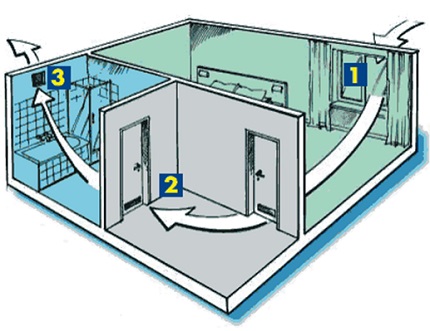
Many residents of apartments face negative factors that indicate problems with the ventilation system:
- Deterioration in air quality. At home there is a lack of oxygen, due to an excess of carbon dioxide, the air becomes stale. The “heavy” atmosphere causes discomfort, headaches and fatigue.
- Stagnation of unpleasant odors. In a "canned" apartment, the aromas accompanying human life are long held. Exhaust appliances in the kitchen or in the bathroom cease to function fully.
- High humidity. A clear sign of the problem is condensation on the windows and wet corners on the walls. Subsequently, black dots - the first manifestations of mold - can be found on surfaces. In such conditions, the decoration of the room is saturated with moisture and gradually destroyed.
If time does not take care of unhindered and regular supply of street air, then the likelihood of allergic and viral diseases increases.

Restoring the intensity of air flow solves these problems.
Regardless of the method selected supply ventilation, it is necessary to provide the following air exchange standards per one living:
- a bedroom, a children's room and a living room - 30 m3 / h;
- kitchen - 60-90 cubic meters / h;
- Bathroom - 25-50 cubic meters / h.
The air supply requirements for the kitchen depend on the type of stove installed. The exact standards for the bathroom are determined on the basis of the joint or separate use of the toilet and the bathroom.
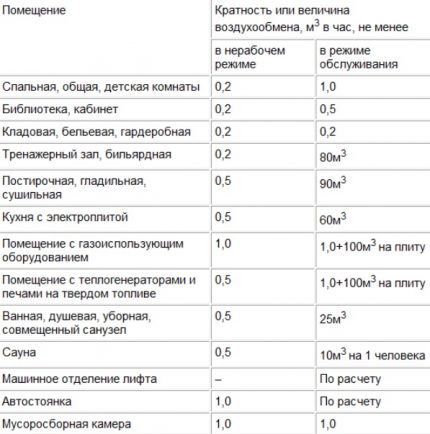
If the room is not operated for permanent housing, then the minimum air exchange rate for residential and non-residential rooms is reduced by 0.2 h-1 and 0.5 h-1, respectively.
Complete information on settlements for the device and modernization of ventilation is given in this article. We recommend that you familiarize yourself with useful information.
Ways to increase the efficiency of air inlets
Various methods aimed at improving the efficiency of supply ventilation are divided into two main categories:
- measures that increase air flow without pressure devices;
- use of forced air systems.
The first group includes: manual or automatic ventilation, installation of a window or wall valve.
Manual ventilation. Opening the window for 15 minutes with a frequency of 3 hours. It is almost impossible to put the method into practice - there is no time or no one to constantly open and close the window. An alternative is to open the sash in micro-ventilation mode.

Automatic airing. A servo drive is installed on the window flap. The device is programmed to open the transom at specified intervals or is equipped with a weather sensor.
An “intelligent” mechanism reacts to changes in humidity and changes in the atmosphere - during rain, strong wind or snow, the sensor will trigger and the window will close on its own.
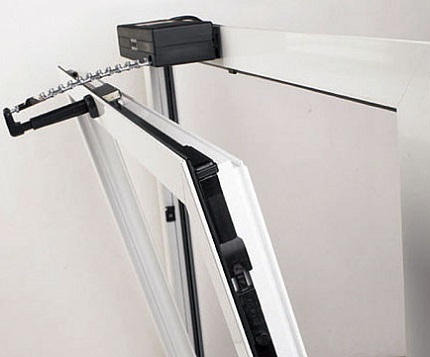
The automatic ventilation method has the same disadvantages as the manual method.
Window and wall valve. Overhead and built-in inlets perform the same function - open access to fresh air flows into the room. Varieties of valves differ in their characteristics and installation technology.
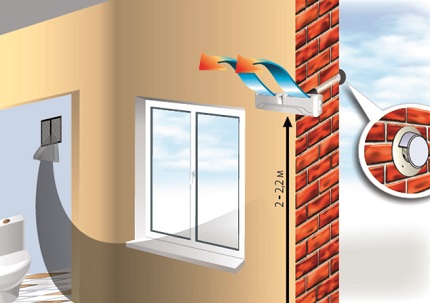
Installation wall unit more complicated than installing the air intake on the window sash, as it requires drilling a through hole through the supporting structural element of the building. Products for windows are cheaper than wall analogues.
Non-channel devices for the forced flow of air jets:
- Ventilators. In fact, this is the same wall valve only with a built-in fan. The intake of fresh air does not depend on the external parameters of the atmosphere (temperature, pressure), but is determined solely by the performance of the fan.
- Breathers. Unlike ventilators, the installation provides high-quality multi-stage filtration. An additional plus is the availability of climate control. The user sets a comfortable temperature, and the “smart” device automatically heats the air.
- Air conditioners with optional air supply. Multifunctional two-unit split complexes with a mixture of air from the outside are equipped with an air duct connecting both buildings, as well as an air mass filtration system.
The listed devices are mounted without laying an air duct and work to supply air to one room. For a comprehensive restoration of the supply function of ventilation in several rooms at once, channel systems are used.

Features of ducted supply systems:
- high performance;
- the possibility of heating the air;
- management automation;
- sufficient sound insulation;
- the high cost of component parts;
- complexity of installation.
Duct ventilation is rarely installed in apartments. Priority areas of application: offices, cottages and public premises.
You will learn how to check the performance of wall and window ventilation valves by reading next article.
Budget options for restoring air exchange
Wall and window valves do not have a fan.The air flow is due to the difference between street and "home" pressure. A prerequisite for the performance of overhead air inlets is good exhaust ventilation.
Features of different types of window valves
The design of all window climate devices is very simple. Standard valve consists of an air intake, a telescopic channel and an indoor unit.
The air intake is mounted outside the frame. The external unit is equipped with a visor and grille, which prevents insects from getting inside. The telescopic channel crashes into the frame, forming a through slot for the unhindered flow of the air stream.
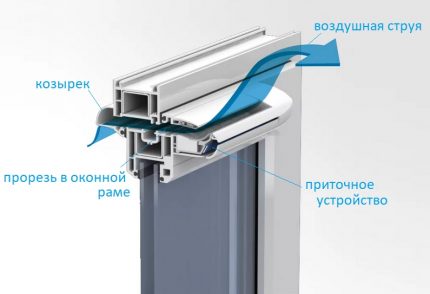
Based on the design and installation method, the following climate devices are distinguished:
- slotted;
- folded;
- waybills.
Slotted models. The throughput of the unit reaches 20 cubic meters per hour - air mass flows through a micro-hole up to 1.6 cm high and up to 4 cm wide. The device consists of two blocks, which complicates its installation - window frame milling is required .
Folded valves. This is the most affordable and easiest way to ventilate a room. The air flow through the slots in the narthex. The main plus of the models is the ability to install on an operated window without milling a groove.
Additional advantages of rebate models include: low cost, preservation of sound-absorbing and heat-retaining properties of PVC glass and the possibility of automation.

Overhead climate products. This option is rarely implemented in the home because of the complexity of installation - the valve is inserted at the assembly stage of the glass packet. In addition, the product degrade the heat and noise insulation of the window.
Overhead modifications have found their application in production and storage facilities. Productivity of climatic devices is about 100 cubic meters / h.
In the simplest models of window air inlets, the size of the slit, and, consequently, the intensity of the air flow, is manually selected - the position of the valve is regulated. High-tech devices are equipped with humidity and atmospheric vibration sensors.
Wall model: device and installation
Externally, the wall valve resembles a cylindrical flask or a wide pipe, with a diameter of about 10-16 cm.
The plastic duct is equipped with the following elements:
- heat-insulating layer - “sleeve” passes through the entire flask, preventing freezing of the wall and reducing the noise effect from the street;
- filter - located at the outlet of the duct, implements rough air cleaning.
In some models, a sealing (silicone) ring with dampers is placed in front of the filter. The purpose of the part is to equalize the air flow in windy weather.

When choosing supply device First of all, the power and “working” temperature of the unit are evaluated. On average, the productivity of a wall-mounted climate product is 40 cubic meters per hour. This value is enough to ventilate a room of 13 sq.m.
The operating temperature range is indicated by the manufacturer on the packaging or in the instrument manual. For severe climatic conditions, special models have been developed that prevent the formation of condensate and the appearance of an ice plug in the channel.
The following photo selection will visually familiarize with the wall valve mounting technology:
Stage 1. Definition of a place. When choosing a wall, you should consider some of the nuances:
- installation is best done on a supporting structure;
- optimal - “exit” of the valve to the insulated loggia;
- it is better to avoid mounting from the roadway.
Valve manufacturers have indicated recommended and undesired installation areas. When installing, it is important to consider the airflow vector.

Stage 2. Wall preparation and drilling. Mark the space under the through hole on the inner wall and draw the diameter of the valve.
Channel drilling order:
- Perform the initial drilling with a diamond crown to a depth of 10 cm.
- Remove debris and chisel a small notch for stable placement of the drill.
- When drilling, adhere to the outward slope - this position of the duct will prevent rainwater from entering the device.
The work is best done with an assistant who will periodically wet the drilling section. Humidification will reduce dust and protect the tool from overheating.
Stage 3. Installation of valve accessories. Clean the groove from dust and place a heat-insulating “sleeve” in the channel. Install the cylindrical body of the device with screwdriving movements, and fasten the fine-mesh lattice on it.
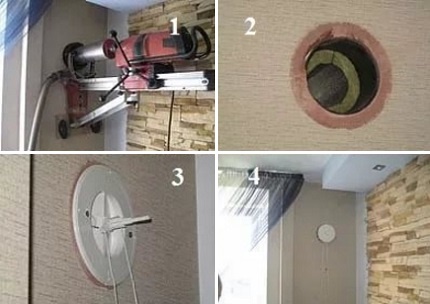
Channelless forced ventilation
Prichochki of this category are considered the best solution to the problems with the supply of fresh air to a high-rise apartment and a private house. They are quite powerful, independent of weather changes, and their installation does not cause special difficulties.
Advanced Wall Valve
Wall-mounted ventilator with the impulse of an air stream is a modernized analogue of a wall supply valve. The fundamental difference in the design is the presence of a fan, which is injected by an air stream.
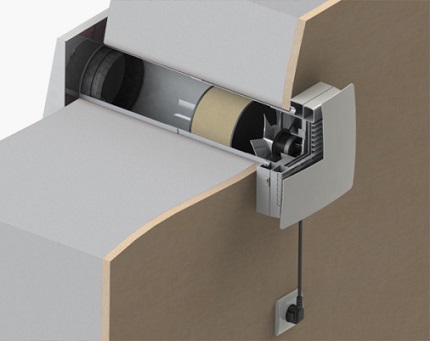
The principle of operation of the ventilator:
- Rotating fan blades pressurize street air.
- Passing through the duct, the air masses are cleaned and enter the apartment.
- The exhaust air moves towards the exhaust ducts and is discharged through the ventilation hole.
The degree of purification of the supplied air flow depends on the built-in filtration system. Optimally, if the ventilator is equipped with different types of filters.
A fan ventilator works even with a poorly efficient exhaust system. Forced feed increases air pressure, which positively affects the performance of the hood.
Breezer - compact air handling unit with climate control
The breather is designed to maintain air circulation inside the premises with an area of 10-50 sq.m. The device simultaneously solves several problems: supplying clean air and heating it to the set temperature values.
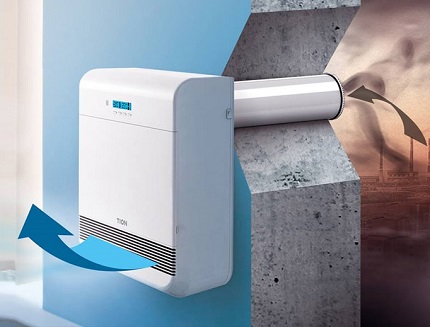
The breather is a technically sophisticated device with the option of climate control and a control system. Components of the air handling unit:
- Air intake with grille - protects the device from insects and rainwater inside.
- An insulated duct is a sealed duct providing air flow. Thermal insulation liner prevents freezing of the wall and reduces noise.
- Automatic damper - opens the channel for the influx of street air after turning on the device and closes after turning off. The element prevents the leakage of cold air into the apartment.
- The fan is responsible for the amount of intake air from the street.
- The communication unit and control system are the “brains” of the breather, which is responsible for all the working processes of the device.
The compact installation is equipped with a complete filtration system. The cascade of filters implements three degrees of purification.
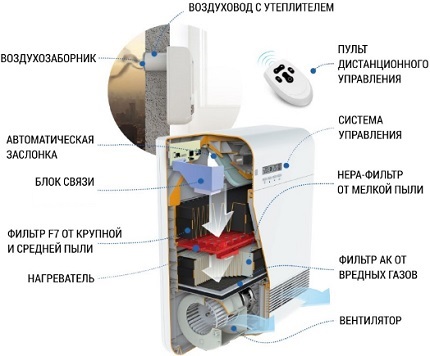
The breather is the optimal solution for creating ventilation in an apartment with filtration, providing up to 80-90% of air mass cleaning from atmospheric dust. The installation process is quite simple:
Fresh Air Conditioners
95% of the split systems on sale operate with static air. They continuously recycle the atmosphere of a closed room. Typical air conditioners perform their main task and the room becomes cooler.However, fresh air from their work is not added.
Manufacturers split systems proposed their own solution to the issue of lack of fresh air and developed air conditioners with a mixture of air from the outside.
Design features of a split system with a stitch:
- air intake is carried out through air ducts going from the external unit to the internal one;
- a turbine with a filtration system, which is responsible for supplying and cleaning air, is provided on the street building.
Some models of air handling units are equipped with an oxygen concentrator, and the oxygen level in the room is controlled by special sensors.
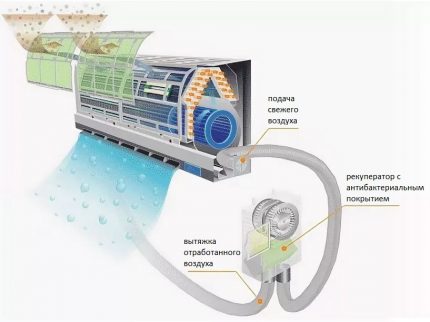
The principle of operation of the "split system with a mixture":
- Fresh air through the suction fan enters through the duct to the evaporative (internal) unit.
- Street air flows mixed with room air.
- After filtering and additional processing (cooling, heating), air flows into the apartment.
Despite the good idea of technologists, such models of climate systems are not in great demand. Air conditioners with air inlet work loudly and are not able to provide full ventilation of the apartment. In addition, the cost of advanced equipment is 20% higher than the price of a conventional air conditioner.
Supply duct multi-systems
Duct ventilation is a complex of air ducts laid in all rooms. The heart of the system is the supply equipment located at the entrance.
The scheme of construction and operation of ventilation is determined by the type of ventilation installation. We outline the features of the two most economical and efficient ways of organizing air supply: ventilation with recovery and the use of VAV units.
The principle of operation of the complex with recovery
The recuperator is a component air handling unit. The heat exchanger can significantly reduce energy consumption, providing heat transfer from the heated exhaust air to the cold incoming streams.
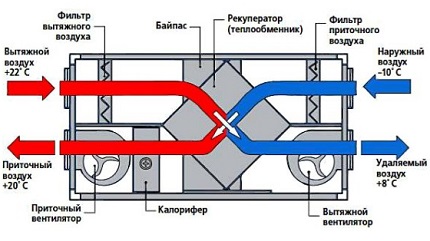
Two types of heat exchangers are installed in ventilation systems: plate and rotary.
Lamellar recuperators. Structurally, they are a cartridge installed in the duct. Air flows are “cut” by a block of plates. Warm air passes on one side of the plate, and cold on the other. Due to heat exchange, condensation is formed which must be removed.
Features of the plate recuperators:
- fresh supply and exhaust air do not mix;
- probability of freezing in winter;
- in recuperators made of vapor-permeable thin films, condensate does not accumulate.
However, the life of such equipment is limited to ten years.
Rotary recuperators. The principle of heat redistribution is based on the rotation of the drum through which versatile air jets move. Gradually, rotating in a drum set, the exhaust air “shares” heat with the rotor sector. When the heated portion of the rotor enters the cold supply stream, the air heats up and the rotor cools.
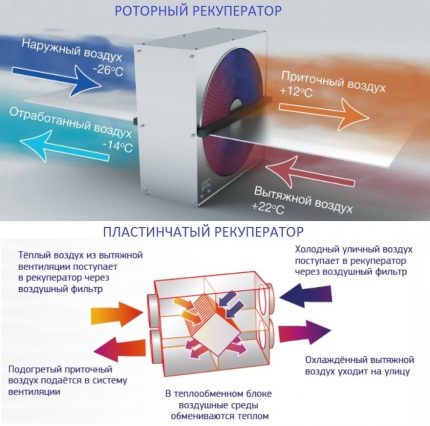
Details about the device and the principle of operation of air conditioning systems with heat recovery are written in this article, which we advise you to familiarize yourself with.
VAV system - ventilation as needed
Variable Air Volume (VAV) installation - an efficient ventilation system that provides air intake and heating with minimal energy consumption. The complex allows you to adjust the parameters and ventilation mode for each room separately.
The standard ventilation system supplies air without taking into account the time of day, the purpose of the room and the number of residents. The performance of the VAV system is selected by the user based on specific operating conditions.
An example of the operation of VAV ventilation. Suppose that a complex with a maximum capacity of 300 cubic meters per hour serves two rooms: a bedroom and a living room. If in winter there wasn’t enough power of a heater to heat the air flow to a comfortable temperature, then in the case of conventional ventilation, the total performance would have to be reduced. As a result, it would be stuffy in both rooms.
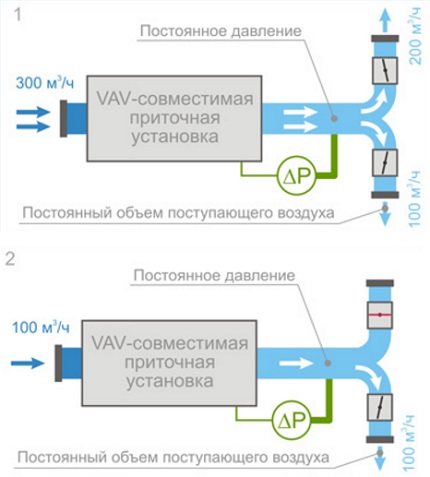
Adjustment of productivity allows to save up to 25-50% of energy in comparison with traditional ventilation.
In addition to reducing electricity bills, the VAV system has other advantages:
- lack of freezing equipment;
- “Mining” is output through the existing ventilation ducts, so there is no need to equip a network of exhaust ducts;
- low cost of operation.
The disadvantage of VAV ventilation is the high price of equipment and difficulties in assembling and adjusting the operability of the complex. Design and installation must be carried out by specialists.
Conclusions and useful video on the topic
Video # 1. Technology for installing Aereco inlet on an operated window construction:
Video # 2. The principle of functioning of the supply ventilation with filtration by the example of the Tion breather:
Video # 3. The scheme of operation of the VAV ventilation system in different modes:
When choosing a method of organizing air exchange, many parameters are taken into account: the pricing policy of the equipment, the efficiency of the installation, the features of operation under different weather conditions, the presence of options for filtering and heating the air masses.
Among the many units, the optimal balance of cost and quality is demonstrated by breathers specially designed for domestic use in the apartment.
Want to talk about how efficient ventilation works in your house / apartment? Perhaps you yourself improved ventilation by installing a breather or a supply valve on the window sash? Please write comments in the block below, share your impressions, opinions and photos on the topic of the article.

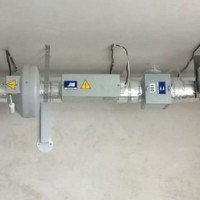 DIY ventilation with heating: the nuances of air heating + assembly instructions for the system
DIY ventilation with heating: the nuances of air heating + assembly instructions for the system 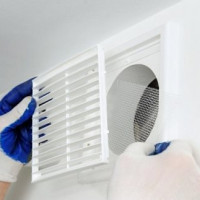 What to do if the ventilation in the apartment and the house does not work? Overview of possible causes and solutions
What to do if the ventilation in the apartment and the house does not work? Overview of possible causes and solutions  Do-it-yourself ventilation of the barn: types of systems, air exchange rates + system arrangement
Do-it-yourself ventilation of the barn: types of systems, air exchange rates + system arrangement  Ventilation in the wardrobe: features of the arrangement of the hood in the dressing room and wardrobe
Ventilation in the wardrobe: features of the arrangement of the hood in the dressing room and wardrobe 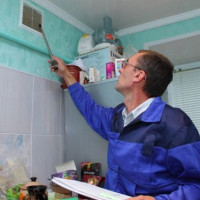 How to get rid of the smell in ventilation: the best options to block the unpleasant smell from the neighbors
How to get rid of the smell in ventilation: the best options to block the unpleasant smell from the neighbors  Supply and exhaust ventilation: principle of operation and features of the arrangement
Supply and exhaust ventilation: principle of operation and features of the arrangement  How much does it cost to connect gas to a private house: the price of organizing gas supply
How much does it cost to connect gas to a private house: the price of organizing gas supply  The best washing machines with dryer: model rating and customer tips
The best washing machines with dryer: model rating and customer tips  What is the color temperature of light and the nuances of choosing the temperature of the lamps to suit your needs
What is the color temperature of light and the nuances of choosing the temperature of the lamps to suit your needs  Replacement of a geyser in an apartment: replacement paperwork + basic norms and requirements
Replacement of a geyser in an apartment: replacement paperwork + basic norms and requirements
Now, it’s just the issue of the supply ventilation device that I’ve taken up, because in our country, in principle, nothing is provided for it in Khrushchev’s. But in winter you won’t open the windows. Hence the humidity comes ... the walls are always wet, and the mold climbs. I'm not talking about smells at all. The methods in your article are, in principle, interesting, I think the wall valves do. Then I will try to unsubscribe about the results.
Better pay attention to the window valve.Why do you need an extra hole in the wall? There is a risk that the wall will freeze and the temperature in the apartment will drop significantly. In case of problems with the window valve, the worst that threatens is replacing the window.
Here I do not agree with you. The supply valve in the wall is a good solution, but here you need to approach responsibly. So that there is no freezing of the wall or the valve itself in the winter, you need to follow technological solutions at all stages of installation. With the correct insert (not by eye), the integrity of the structure will practically not be violated. In order not to have a strong decrease in temperature, a special valve system is provided in the apartment. You can also make a practical solution in the form of a supply wall valve above the radiator.
At the same time, the supply ventilation realized through openings in the window frames is much more negative. And the flow of air will not always come in the right amount - this is a fact. Sometimes it makes sense to combine a supply valve in a wall in one room and in a window in another.
For ventilation, we leave the window ajar for the night. The bedroom is far from the kitchen, so we do not freeze and breathe fresh air. We do not have a busy track outside the windows, we live on the edge of the city. In the summer we arrange small drafts. We open the window and balcony on the other side of the apartment. We noticed that without airing, the head begins to hurt and there is nothing to breathe, so we do not neglect this event.